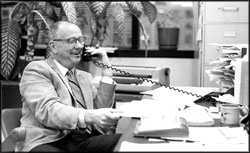
| Vol.
XXII No.
4 March / April / May 2010 |
| contents |
| Printable Version |
In Memoriam
Arthur C. Smith

(click on image to enlarge)
When Art Smith died last week, MIT lost a 50-year member of the community. When it comes to thinking about contributing members of the Institute, Art was always my best illustration. From Chair of the Committee on Academic Performance (1972-1974) to Chair of the Faculty (1983-1985) to Dean for Undergraduate Education (1990) Art was always willing to take on the task MIT asked of him. Whereas all these official efforts were important, it was the quiet leadership Art exhibited that touched so many areas removed from his formal roles.
Art was raised in Oklahoma and educated at the University of Kansas and Harvard. He came to MIT in 1959, and I always thought his commitment to students grew out of remembering where he had started. I arrived at MIT in 1979 while Art was acting head of the Office of Minority Education. When I went to see him I sat outside his office, and through the glass watched one side of his conversation with his daughter, Amy. I learned two things that day: 1) his daughters always came first, and 2) never assume. Seeing Amy, I assumed she was adopted since I also assumed that the Head of OME would be black. Imagine my surprise.
But that was part of who Arthur Smith was. He believed in equality not because it was trendy, but because it was right. He had worked with Paul Gray and others to level the playing field in EECS for all students. It was a commitment he believed in and made real by actions. Later, the Committee on Student Affairs benefited from his leadership and he worked with the Minority Student Issues Group.
In 1990 Art began a term as Dean for Undergraduate Education that morphed into the Dean for Undergraduate Education and Student Affairs on the resignation of Dean Shirley McBay. He held the office for five years and turned over the roll to Roz Williams in 1995. He oversaw the renovation of Senior House, a very emotional project. He also had the unfortunate experience of learning first hand the power of the press, when he mentioned in passing to The Tech that Ashdown House ought to be an undergraduate dorm. The reaction was quick and negative, but his wisdom was confirmed with the decision to build a new Ashdown and renovate the older residence for undergraduates. It only took 25 years to come to fruition! He was more careful with his comments to The Tech during the remainder of his time as Dean.
Art’s commitment on issues of race also carried over to matters of gender. According to Sheila Widnall, he had done a study of the relationship between the Math SAT and the graduating cumulative grade point average for both men and women.
He found that the Math SAT under-predicted the performance of women by about 30-40 points. This was the basis on which admissions decisions were modified. In one year, the percentage of women in the freshman class went from 26% to 38% (1990) and climbed thereafter. The subsequent results of the performance of women as MIT students confirmed expectations.
Art was a faculty leader. He was one of those who could bring faculty and the administration together in the event of a critical issue. He was central to the governance of MIT during difficult times; Viet Nam, and divestment from South Africa immediately come to mind, but matters of student privacy were also important to him, and he weighed in to support the right of students to grow into adulthood protected from prying eyes. He was a key contributor to the faculty and administration working effectively together – which is how MIT does its best work.
Art could also be stubborn; but there is a fine line between being stubborn and holding steady. Young people can disappoint you when you expect the most of them, but Art did not let disappointment keep him from believing in our students. When then-provost John Deutch appointed him dean, he spoke of “[Art’s] deep understanding of the institution and the concerns of the students, developed over more than 30 years as a teacher, faculty leader, advisor, and father of two graduates.” John could have also mentioned his passion for the Celtics, his ability to cook and bake, his interest in making good beer, and the textbooks he co-authored. He did not need to mention everything Art gave us; he couldn’t have because for over 50 years Arthur C. Smith lived a life marked by quiet commitment to family, community, and MIT. We are the better for what he gave us and we owe his family thanks for sharing him with us.
| Back to top | |
| Send your comments |
| home this issue archives editorial board contact us faculty website |